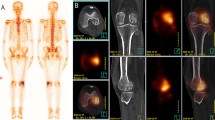Abstract
Objective
To compare the diagnostic ability of planar images (PI) and images obtained by a computer-aided diagnosis (CAD) system (Viewer for Standardized Bone Scintigraphies; VSBONE) of whole-body bone scintigraphy for detecting bone metastases in breast cancer patients.
Methods
81 women (median: 56 years; range: 32–79) with a history of breast cancer were included in this study. They underwent whole-body bone scintigraphy after intravenous injection of 740 MBq technetium-99m hydroxymethylene diphosphonate. A total of 1066 bones (162 regions of the skull, 657 regions of the spine and pelvis, 223 regions of the sternum and rib, 18 regions of the upper extremities, and 6 regions of the lower extremities) were analyzed. The PI alone, VSBONE images alone, and both PI and VSBONE images (PI + VSBONE) were interpreted independently by two radiologists to diagnose bone metastases, which were then confirmed by magnetic resonance imaging. The sensitivity and specificity for each modality were analyzed using Fisher’s exact and McNemar tests. Inter-reviewer agreement was evaluated using a kappa statistic.
Results
Bone metastases were confirmed in 43 patients with 442 positive lesions. The average sensitivity of PI, VSBONE images, and PI + VSBONE images was 40.8, 50.2, and 61.8 %, respectively. The average specificity was 97.8, 97.5, and 97.6 %, respectively. The kappa scores were 0.62 for PI, 0.69 for VSBONE, and 0.77 for PI + VSBONE.
Conclusions
VSBONE was superior to PI in regard to sensitivity for detecting bone metastases in breast cancer patients. However, an improved CAD system is required to decrease the number of false-negative results.



Similar content being viewed by others
References
Maffioli L, Florimonte L, Pagani L, Butti I, Roca I. Current role of bone scan with phosphonates in the follow-up of breast cancer. Eur J Nucl Med Mol Imaging. 2004;31:143–8.
Hayashi N, Yamauchi H, Nakamura S. Management of bone metastases from breast cancer. Gan To Kagaku Ryoho. 2012;39:1174–7.
Costa L. Bisphosphonates: reducing the risk of skeletal complications from bone metastasis. Breast. 2007;16:16–20.
Jeremic B, Shibamoto Y, Acimovic L, Milicic B, Milisavljevic S, Nikolic N, et al. A randomized trial of three single-dose radiation therapy regimens in the treatment of metastatic bone pain. Int J Radiat Oncol Biol Phys. 1998;42:161–7.
Duo J, Han X, Zhang L, Wang G, Ma Y, Yang Y. Comparison of FDG PET/CT and gadolinium-enhanced MRI for the detection of bone metastases in patients with cancer: a meta-analysis. Clin Nucl Med. 2013;38:343–8.
Shen CT, Qiu ZL, Han TT, Luo QY. Performance of 18F-fluoride PET or PET/CT for the detection of bone metastases: a meta-analysis. Clin Nucl Med. 2015;40:103–10.
Brennan ME, Houssami N. Evaluation of the evidence on staging imaging for detection of asymptomatic distant metastases in newly diagnosed breast cancer. Breast. 2012;21:112–23.
Azad GK, Taylor B, Rubello D, Colletti PM, Goh V, Cook GJ. Molecular and functional imaging of bone metastases in breast and prostate cancers: an overview. Clin Nucl Med. 2016;41:e44–50.
Tokuda O, Harada Y, Ohishi Y, Matsunaga N, Edenbrandt L. Investigation of computer-aided diagnosis system for bone scans: a retrospective analysis in 406 patients. Ann Nucl Med. 2014;28:329–39.
Bombardieri E, Aktolun C, Baum RP, Bishof-Delaloye A, Buscombe J, Chatal JF, et al. Bone scintigraphy procedures guidelines for tumor imaging. Eur J Nucl Med Mol Imaging. 2003;30:107–14.
Shiraishi J, Li Q, Appelbaum D, Pu Y, Doi K. Development of a computer-aided diagnostic scheme for detection of interval changes in successive whole-body bone scans. J Digit Imaging. 2011;24:680–7.
Landis JR, Koch CG. The measurement of observer agreement for categorical data. Biometrics. 1977;33:9–74.
Liu T, Cheng T, Xu W, Yan WL, Liu J, Yang HL. A meta-analysis of 18FDG-PET, MRI and bone scintigraphy for diagnosis of bone metastases in patients with breast cancer. Skelet Radiol. 2011;40:523–31.
Mitsui Y, Shiina H, Yamamoto Y, Haramoto M, Arichi N, Yasumoto H, et al. Prediction of survival benefit using an automated bone scan index in patients with castration-resistant prostate cancer. BJU Int. 2012;110:628–34.
Niikura N, Hashimoto J, Kazama T, Koizumi J, Ogiya R, Terao M, et al. Diagnostic performance of 18F-fluorodeoxyglucose PET/CT and bone scintigraphy in breast cancer patients with suspected bone metastasis. Breast Cancer. 2015. doi:10.1007/s12282-015-0621-z.
Even-Sapir E, Metser U, Mishani E, Lievshitz G, Lerman H, Leibovitch I. The detection of bone metastases in patients with high-risk prostate cancer: 99mTc-MDP planar bone scintigraphy, single- and multi-field-of-view SPECT, 18F-Fluoride PET, and 18F-Fluoride PET/CT. J Nucl Med. 2006;47:287–97.
Jambor I, Kuisma A, Ramadan S, Huovinen R, Sandell M, Kajander S, et al. Prospective evaluation of planar bone scintigraphy, SPECT, SPECT/CT, 18F-NaF PET/CT and whole body 1.5T MRI, including DWI, for the detection of bone metastases in high risk breast and prostate cancer patients: SKELETA clinical trial. Acta Oncol. 2015;2:1–9.
Engelhard K, Hollenbach HP, Wohlfart K, von Imhoff E, Fellner FA. Comparison of whole-body MRI with automatic moving table technique and bone scintigraphy for screening for bone metastases in patients with breast cancer. Eur Radiol. 2004;14:99–105.
Koizumi M, Miyaji N, Murata T, Motegi K, Miwa K, Koyama M, et al. Evaluation of a computer-assisted diagnosis system, BONENAVI version 2, for bone scintigraphy in cancer patients in a routine clinical setting. Ann Nucl Med. 2015;29:138–48.
Sharma P, Singh H, Kumar R, Bal C, Thulkar S, Seenu V, Malhotra A. Bone scintigraphy in breast cancer: added value of hybrid SPECT-CT and its impact on patient management. Nucl Med Commun. 2012;33:139–47.
Janicek MJ, Hayes DF, Kaplan WD. Healing flare in skeletal metastases from breast cancer. Radiology. 1994;192:201–4.
Author information
Authors and Affiliations
Corresponding author
Ethics declarations
Conflict of interest
No authors have any conflicts of interest.
Rights and permissions
About this article
Cite this article
Urano, M., Maki, Y., Nishikawa, H. et al. Diagnostic utility of a computer-aided diagnosis system for whole-body bone scintigraphy to detect bone metastasis in breast cancer patients. Ann Nucl Med 31, 40–45 (2017). https://doi.org/10.1007/s12149-016-1132-5
Received:
Accepted:
Published:
Issue Date:
DOI: https://doi.org/10.1007/s12149-016-1132-5




